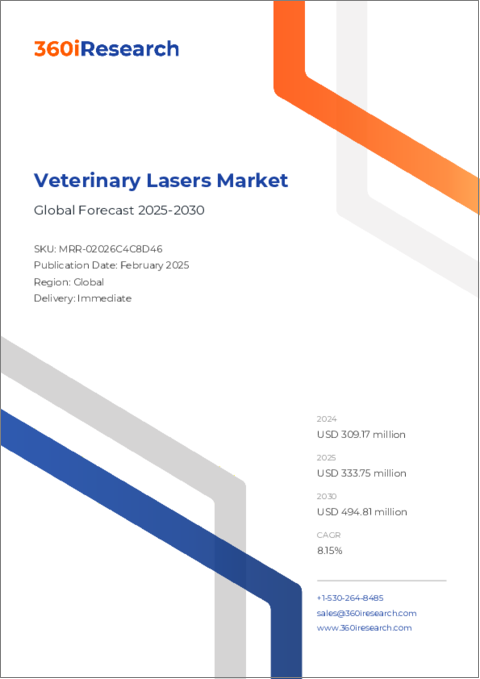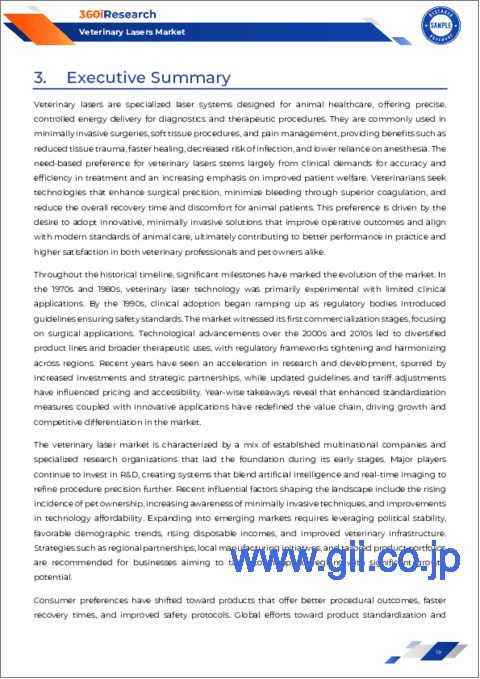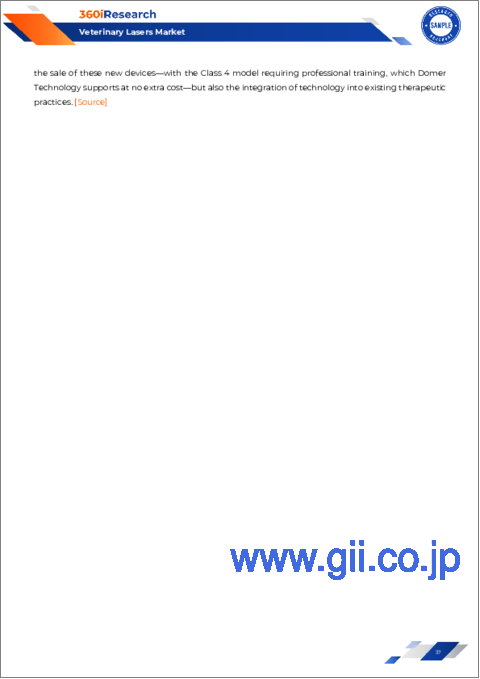|
|
市場調査レポート
商品コード
1570575
獣医用レーザー市場、機会、成長促進要因、産業動向分析と予測、2024年~2032年Veterinary Lasers Market, Opportunity, Growth Drivers, Industry Trend Analysis and Forecast, 2024-2032 |
||||||
カスタマイズ可能
|
|||||||
| 獣医用レーザー市場、機会、成長促進要因、産業動向分析と予測、2024年~2032年 |
|
出版日: 2024年08月02日
発行: Global Market Insights Inc.
ページ情報: 英文 200 Pages
納期: 2~3営業日
|
- 全表示
- 概要
- 目次
世界の獣医用レーザー市場は、2023年に3億7,620万米ドルと評価され、2024年から2032年までCAGR 9.8%で成長すると予測されています。
市場の力強い成長は、主に動物における慢性疾患の有病率の上昇によって促進され、この動向はヘルスケア成果の改善を目的とした高度な獣医技術の採用によってさらに増幅されています。
獣医用レーザーの技術的進歩は、治療と手術の両方のアプリケーションを強化し、それによって市場の需要を押し上げています。これらの技術革新は、レーザー手術をより正確に、より低侵襲に、そして顕著に効果的にし、その結果、動物の回復時間を短縮し、より良い結果をもたらしています。アクセシビリティと利便性に対する需要の高まりを受けて、大手企業はユーザーのニーズに応える最先端の技術革新を提供することに力を注いでおり、市場の拡大を牽引しています。その顕著な例が、Erchonia社のVGL Vet Laser Systemの発売であり、世界初のグリーンレーザーとバイオレットレーザーのコンボとして注目されています。この二波長装置は2023年にFDAの人間用認可を取得し、その比類ない治療効果で動物医療に革命を起こそうとしています。
獣医用レーザー産業は、動物タイプ、製品タイプ、レーザタイプ、技術、モダリティ、アプリケーション、エンドユーザ、地域に区分されます。
動物タイプに基づく市場セグメントには、コンパニオンアニマル、家畜が含まれます。2023年、コンパニオンアニマルセグメントは2億8,740万米ドルの収益で市場をリードし、予測期間中CAGR 9.7%で成長すると予測されています。このセグメントが主導権を握っている主な理由は、慢性疾患の有病率が上昇していることと、ペットの飼い主の間で非侵襲的処置に対する意識が高まっていることです。さらに、ペット保険の普及、ペット数の拡大、ペットケアへの支出増がこの市場の大きな促進要因となっています。
市場はレーザタイプを治療用レーザ、手術用レーザ、デュアルアプリケーションレーザに分類しています。2023年、治療用レーザセグメントは61.1%と圧倒的な市場シェアを占め、分析期間を通してこのポジションを維持すると予測されています。その優位性は、幅広い適用範囲と疼痛管理、創傷治癒、炎症軽減で実証された効果に起因しています。ペットの関節炎や関節の問題のような慢性疾患の発生率の上昇が、治療用レーザの需要をさらに加速しています。
2023年、米国は1億5,310万米ドルの評価額で北米獣医用レーザ市場をリードし、今後数年で大きく成長する構えです。米国のリーダーシップは、高度な獣医ヘルスケアインフラと革新的技術の迅速な導入に起因します。ペット数が多く、ペットヘルスケアへの支出が高まっていることも相まって、これらの要因が高度なレーザ治療の需要を増幅しています。
目次
第1章 調査手法と調査範囲
第2章 エグゼクティブサマリー
第3章 業界洞察
- エコシステム分析
- 業界への影響要因
- 促進要因
- 動物個体数と飼育率の増加
- 動物の慢性疾患の増加
- 非侵襲的治療に対する意識の高まり
- 技術の進歩
- ペット保険導入の増加
- 業界の潜在的リスク&課題
- 規制上の課題
- 代替治療の採用
- 促進要因
- 成長可能性分析
- 技術情勢
- 規制状況
- 今後の市場動向
- ポーター分析
- PESTEL分析
第4章 競合情勢
- イントロダクション
- 企業シェア分析
- 企業マトリックス分析
- 主要市場プレーヤーの競合分析
- 競合のポジショニングマトリックス
- 戦略ダッシュボード
第5章 市場推計・予測:動物タイプ別、2021年~2032年
- 主要動向
- コンパニオンアニマル
- 畜産動物
第6章 市場推計・予測:レーザータイプ別、2021年~2032年
- 主要動向
- 治療用レーザー
- 手術用レーザー
- デュアルアプリケーションレーザー
第7章 市場推計・予測:製品タイプ別、2021年~2032年
- 主要動向
- クラス2
- クラス3
- クラス3B
- クラス3R
- クラス4
第8章 市場推計・予測:技術別、2021年~2032年
- 主要動向
- CO2
- ダイオード
- その他の技術
第9章 市場推計・予測:モダリティ別、2021年~2032年
- 主要動向
- 卓上型
- ハンドヘルド
- オンキャスター
第10章 市場推計・予測:用途別、2021年~2032年
- 主要動向
- 疼痛管理
- 慢性関節炎
- 創傷治療
- 外傷治療
- その他の用途
第11章 市場推計・予測:エンドユーザー別、2021年~2032年
- 主要動向
- 動物病院
- 動物クリニック
- 在宅ケア
- 研究機関
第12章 市場推計・予測:地域別、2021年~2032年
- 主要動向
- 北米
- 米国
- カナダ
- 欧州
- ドイツ
- 英国
- フランス
- スペイン
- イタリア
- オランダ
- その他欧州
- アジア太平洋
- 日本
- 中国
- インド
- オーストラリア
- 韓国
- その他アジア太平洋地域
- ラテンアメリカ
- ブラジル
- メキシコ
- その他ラテンアメリカ
- 中東・アフリカ
- サウジアラビア
- 南アフリカ
- アラブ首長国連邦
- その他中東とアフリカ
第13章 企業プロファイル
- ASAveterinary
- BIOLASE, Inc.
- Cutting Edge Laser Technologies
- Erchonia
- FISIOLINE
- GLOBUS SPORT AND HEALTH TECHNOLOGIES LLC
- IMV Imaging
- IRIDEX Corporation
- LAMBDA S.p.A.
- Multi Radiance Medical
- SpectraVET
- Summus Laser
- VetScalpel
The Global Veterinary Lasers Market was valued at USD 376.2 million in 2023 and is projected to grow at a CAGR of 9.8% from 2024 to 2032. The market's robust growth is primarily fueled by the rising prevalence of chronic diseases in animals, a trend further amplified by the adoption of advanced veterinary technologies aimed at improving healthcare outcomes.
Technological advancements in veterinary lasers are enhancing both therapeutic and surgical applications, thereby boosting market demand. These innovations have rendered laser surgeries more precise, less invasive, and notably effective, resulting in shorter recovery times and better outcomes for animals. In response to the growing demand for accessibility and convenience, major players are committed to delivering state-of-the-art technological innovations that cater to user needs, driving market expansion. A notable example is Erchonia's launch of the VGL Vet Laser System, touted as the world's first green and violet laser combo. This dual-wavelength device, which received FDA clearance for human use in 2023, is set to revolutionize veterinary care with its unparalleled treatment efficacy.
The veterinary lasers industry is segmented into animal type, product type, laser type, technology, modality, application, end-user, and region.
The market segments based on animal type include companion animals and livestock. In 2023, the companion animal segment led the market with a revenue of USD 287.4 million and is projected to grow at a CAGR of 9.7% during the forecast period. This segment's leadership is largely due to the rising prevalence of chronic diseases and heightened awareness of non-invasive procedures among pet owners. Furthermore, the growing adoption of pet insurance, an expanding pet population, and increased spending on pet care are significant drivers of this market.
The market classifies laser types into therapeutic lasers, surgical lasers, and dual application lasers. In 2023, the therapeutic lasers segment commanded a dominant market share of 61.1% and is expected to retain this position throughout the analysis period. Their dominance stems from a broad application range and proven efficacy in pain management, wound healing, and inflammation reduction. The rising incidence of chronic conditions, like arthritis and joint issues in pets, has further spurred the demand for therapeutic lasers.
In 2023, the U.S. led the North American veterinary lasers market with a valuation of USD 153.1 million and is poised for significant growth in the coming years. The U.S.'s leadership can be attributed to its advanced veterinary healthcare infrastructure and a swift adoption of innovative technologies. Coupled with a large pet population and heightened spending on pet healthcare, these factors amplify the demand for advanced laser treatments.
Table of Contents
Chapter 1 Methodology and Scope
- 1.1 Market scope and definitions
- 1.2 Research design
- 1.2.1 Research approach
- 1.2.2 Data collection methods
- 1.3 Base estimates and calculations
- 1.3.1 Base year calculation
- 1.3.2 Key trends for market estimation
- 1.4 Forecast model
- 1.5 Primary research and validation
- 1.5.1 Primary sources
- 1.5.2 Data mining sources
Chapter 2 Executive Summary
- 2.1 Industry 360° synopsis
Chapter 3 Industry Insights
- 3.1 Industry ecosystem analysis
- 3.2 Industry impact forces
- 3.2.1 Growth drivers
- 3.2.1.1 Increasing animal population and ownership rates
- 3.2.1.2 Growing chronic diseases in animals
- 3.2.1.3 Increased awareness about non-invasive treatments
- 3.2.1.4 Advancements in technology
- 3.2.1.5 Increasing pet insurance adoption
- 3.2.2 Industry pitfalls and challenges
- 3.2.2.1 Regulatory challenges
- 3.2.2.2 Adoption of alternative treatment
- 3.2.1 Growth drivers
- 3.3 Growth potential analysis
- 3.4 Technology landscape
- 3.5 Regulatory landscape
- 3.6 Future market trends
- 3.7 Porter's analysis
- 3.8 PESTEL analysis
Chapter 4 Competitive Landscape, 2023
- 4.1 Introduction
- 4.2 Company market share analysis
- 4.3 Company matrix analysis
- 4.4 Competitive analysis of major market players
- 4.5 Competitive positioning matrix
- 4.6 Strategy dashboard
Chapter 5 Market Estimates and Forecast, By Animal Type, 2021 - 2032 ($ Mn)
- 5.1 Key trends
- 5.2 Companion animals
- 5.3 Livestock animals
Chapter 6 Market Estimates and Forecast, By Laser Type, 2021 - 2032 ($ Mn)
- 6.1 Key trends
- 6.2 Therapeutic lasers
- 6.3 Surgical lasers
- 6.4 Dual application lasers
Chapter 7 Market Estimates and Forecast, By Product Type, 2021 - 2032 ($ Mn)
- 7.1 Key trends
- 7.2 Class 2
- 7.3 Class 3
- 7.3.1 Class 3B
- 7.3.2 Class 3R
- 7.4 Class 4
Chapter 8 Market Estimates and Forecast, By Technology, 2021 - 2032 ($ Mn)
- 8.1 Key trends
- 8.2 CO2
- 8.3 Diode
- 8.4 Other technologies
Chapter 9 Market Estimates and Forecast, By Modality, 2021 - 2032 ($ Mn)
- 9.1 Key trends
- 9.2 Table-top
- 9.3 Hand-held
- 9.4 On-caster
Chapter 10 Market Estimates and Forecast, By Application, 2021 - 2032 ($ Mn)
- 10.1 Key trends
- 10.2 Pain management
- 10.3 Chronic arthritis
- 10.4 Wound therapy
- 10.5 Traumatic injuries
- 10.6 Other applications
Chapter 11 Market Estimates and Forecast, By End-user, 2021 - 2032 ($ Mn)
- 11.1 Key trends
- 11.2 Veterinary hospitals
- 11.3 Veterinary clinics
- 11.4 Home care
- 11.5 Research institutes
Chapter 12 Market Estimates and Forecast, By Region, 2021 - 2032 ($ Mn)
- 12.1 Key trends
- 12.2 North America
- 12.2.1 U.S.
- 12.2.2 Canada
- 12.3 Europe
- 12.3.1 Germany
- 12.3.2 UK
- 12.3.3 France
- 12.3.4 Spain
- 12.3.5 Italy
- 12.3.6 The Netherlands
- 12.3.7 Rest of Europe
- 12.4 Asia Pacific
- 12.4.1 Japan
- 12.4.2 China
- 12.4.3 India
- 12.4.4 Australia
- 12.4.5 South Korea
- 12.4.6 Rest of Asia Pacific
- 12.5 Latin America
- 12.5.1 Brazil
- 12.5.2 Mexico
- 12.5.3 Rest of Latin America
- 12.6 Middle East and Africa
- 12.6.1 Saudi Arabia
- 12.6.2 South Africa
- 12.6.3 UAE
- 12.6.4 Rest of Middle East and Africa
Chapter 13 Company Profiles
- 13.1 ASAveterinary
- 13.2 BIOLASE, Inc.
- 13.3 Cutting Edge Laser Technologies
- 13.4 Erchonia
- 13.5 FISIOLINE
- 13.6 GLOBUS SPORT AND HEALTH TECHNOLOGIES LLC
- 13.7 IMV Imaging
- 13.8 IRIDEX Corporation
- 13.9 LAMBDA S.p.A.
- 13.10 Multi Radiance Medical
- 13.11 SpectraVET
- 13.12 Summus Laser
- 13.13 VetScalpel






